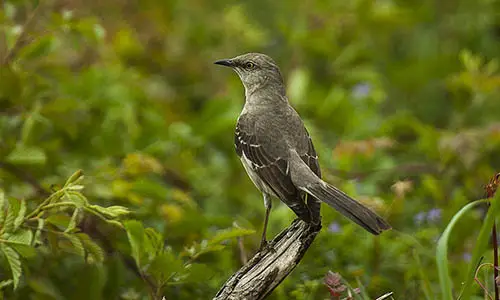The mocking bird is a small, drab, nondescript bird found in the New World. The mockingbird is a passerine. It has three toes in front and one behind, to facilitate perching. The mockingbird comes from the family Mimidae that includes thrashers, and tremblers. They are often called the New World catbirds because the wailing sound that they sometimes make resembles the mewing of a cat. There are about 10 species of mockingbirds in the genus Mimus. They can be found through the Americas, from the tip of South America to Canada. Along with the Native Americans, the mockingbirds inhabited the Americas long before Christopher Columbus arrived. They played an important role in Native American culture throughout the Americas. They have a vast mythological significance ranging from ‘guardian of the dead’ to being a symbol of intelligence. They have also been considered a ‘medicine bird’ and are the legendary teachers of speech to the Hopi and Pueblo tribes.
FACT 1: The mockingbird is a small, plain looking bird. It has thin legs and is a drab grey colour. There is very little difference between the male and female. They both have white wing patches and white outer tail feathers. These slender little birds are between 9 and 11 inches long.
FACT 2: The Native Americans called them ‘cencotlatolly’, meaning 400 tongues. This is an apt name. The mockingbird is essentially a song bird, it sings throughout the day and sometimes in the night. Aside from its own melody, the mockingbird mimics the calls of other birds. Its repertoire also includes the sound of a croaking frog, barking dog, chirping cricket and even mechanical sounds like a squeaking gate or a car starting.
FACT 3: Of the ten species from genus Mimus, the Northern Mocking Bird is the best known. Its scientific name is Mimus polyglottis, from the Greek mimus meaning mimic and polyglottis meaning many tongued. The prefix Northern is added as the Mimus polyglottis is the only mocking bird found north of Mexico.
FACT 4: The Northern Mockingbird, despite its drab appearance is the State bird of five American States; Arkansas, Florida, Mississippi, Tennessee and Texas. This honour has been conferred on it for the harmonious melodies that bring so much joy to those who hear it. The Northern Mockingbird, has, stored in its little voice box, up to 200 songs.
FACT 5: Of the nine other species in the genus Mimus, the Tropical or Bahama Mocking bird is so called because it lives in the tropics. The mockingbirds of Mexico and Central America are differently coloured. They are an electric blue and so are called the Blue Mocking Birds. The Socorro Mocking Bird endemic to the Revillagigedo Islands is severely endangered.
FACT 6: The four species of mocking bird found on the Galapagos archipelago are from the genus Nesomimus. It was the study of these birds, especially the Floreana Mockingbird that was the key to the formation of Darwin’s ‘Theory of Life’. Sadly this bird is now extinct in the island that gave it its name.
FACT 7: The mockingbird symbolises innocence. This death of this innocence is the theme Harper Lee’s bestselling book ‘To Kill a Mockingbird’. According to one of the characters in the book, it is a sin to kill a mockingbird. The mockingbird does nothing but sing for us, she says.
FACT 8: This view of the mockingbird is of course only literary. In reality the mocking is a fiercely territorial bird. It stakes out its territory and defends it against all intruders, no matter the size and shape. Though they are too small to cause much damage, intruders often leave to escape the nuisance of incessantly pecking beaks.
FACT 9: Urban mockingbirds are also great teases. They have been known to harass house dogs and cats even if these animals are nowhere near the nests. Mockingbirds have been observed dive bombing cats until the cats had to run for cover.
FACT 10: Urban mockingbirds are extremely savvy. Within a minute of meeting humans they can tell one person from another.











Leave a Reply